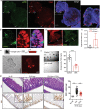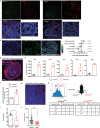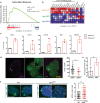A non-dividing cell population with high pyruvate dehydrogenase kinase activity regulates metabolic heterogeneity and tumorigenesis in the intestine
- PMID: 35314684
- PMCID: PMC8938512
- DOI: 10.1038/s41467-022-29085-y
A non-dividing cell population with high pyruvate dehydrogenase kinase activity regulates metabolic heterogeneity and tumorigenesis in the intestine
Abstract
Although reprogramming of cellular metabolism is a hallmark of cancer, little is known about how metabolic reprogramming contributes to early stages of transformation. Here, we show that the histone deacetylase SIRT6 regulates tumor initiation during intestinal cancer by controlling glucose metabolism. Loss of SIRT6 results in an increase in the number of intestinal stem cells (ISCs), which translates into enhanced tumor initiating potential in APCmin mice. By tracking down the connection between glucose metabolism and tumor initiation, we find a metabolic compartmentalization within the intestinal epithelium and adenomas, where a rare population of cells exhibit features of Warburg-like metabolism characterized by high pyruvate dehydrogenase kinase (PDK) activity. Our results show that these cells are quiescent cells expressing +4 ISCs and enteroendocrine markers. Active glycolysis in these cells suppresses ROS accumulation and enhances their stem cell and tumorigenic potential. Our studies reveal that aerobic glycolysis represents a heterogeneous feature of cancer, and indicate that this metabolic adaptation can occur in non-dividing cells, suggesting a role for the Warburg effect beyond biomass production in tumors.
© 2022. The Author(s).
Conflict of interest statement
N.Y.R.A. is key opinion leader for Bruker Daltonics, scientific advisor to Invicro, and receives support from Thermo Finnegan and EMD Serono. R.M. is a founder of Galilei Biosciences.
Figures





Similar articles
-
SIRT3 elicited an anti-Warburg effect through HIF1α/PDK1/PDHA1 to inhibit cholangiocarcinoma tumorigenesis.Cancer Med. 2019 May;8(5):2380-2391. doi: 10.1002/cam4.2089. Epub 2019 Apr 16. Cancer Med. 2019. PMID: 30993888 Free PMC article.
-
The histone deacetylase SIRT6 is a tumor suppressor that controls cancer metabolism.Cell. 2012 Dec 7;151(6):1185-99. doi: 10.1016/j.cell.2012.10.047. Cell. 2012. PMID: 23217706 Free PMC article.
-
Regulating the Warburg effect on metabolic stress and myocardial fibrosis remodeling and atrial intracardiac waveform activity induced by atrial fibrillation.Biochem Biophys Res Commun. 2019 Aug 27;516(3):653-660. doi: 10.1016/j.bbrc.2019.06.055. Epub 2019 Jun 23. Biochem Biophys Res Commun. 2019. PMID: 31242971
-
The roles of sirtuins family in cell metabolism during tumor development.Semin Cancer Biol. 2019 Aug;57:59-71. doi: 10.1016/j.semcancer.2018.11.003. Epub 2018 Nov 16. Semin Cancer Biol. 2019. PMID: 30453040 Review.
-
Targeting pyruvate dehydrogenase kinase signaling in the development of effective cancer therapy.Biochim Biophys Acta Rev Cancer. 2021 Aug;1876(1):188568. doi: 10.1016/j.bbcan.2021.188568. Epub 2021 May 21. Biochim Biophys Acta Rev Cancer. 2021. PMID: 34023419 Review.
Cited by
-
Robustness of the Krebs Cycle under Physiological Conditions and in Cancer: New Clues for Evaluating Metabolism-Modifying Drug Therapies.Biomedicines. 2022 May 22;10(5):1199. doi: 10.3390/biomedicines10051199. Biomedicines. 2022. PMID: 35625935 Free PMC article.
-
Old mitochondria regulate niche renewal via α-ketoglutarate metabolism in stem cells.Nat Metab. 2025 Jul;7(7):1344-1357. doi: 10.1038/s42255-025-01325-7. Epub 2025 Jul 14. Nat Metab. 2025. PMID: 40659911 Free PMC article.
-
SIRT4 loss reprograms intestinal nucleotide metabolism to support proliferation following perturbation of homeostasis.Cell Rep. 2024 Apr 23;43(4):113975. doi: 10.1016/j.celrep.2024.113975. Epub 2024 Mar 19. Cell Rep. 2024. PMID: 38507411 Free PMC article.
-
The emerging role of intestinal stem cells in ulcerative colitis.Front Med (Lausanne). 2025 Mar 25;12:1569328. doi: 10.3389/fmed.2025.1569328. eCollection 2025. Front Med (Lausanne). 2025. PMID: 40201327 Free PMC article. Review.
-
Development of a Dual Reporter System to Simultaneously Visualize Ca2+ Signals and AMPK Activity.ACS Sens. 2024 Sep 27;9(9):4680-4689. doi: 10.1021/acssensors.4c01058. Epub 2024 Aug 21. ACS Sens. 2024. PMID: 39167044 Free PMC article.
References
Publication types
MeSH terms
Substances
Grants and funding
- T32 EB025823/EB/NIBIB NIH HHS/United States
- P30 DK040561/DK/NIDDK NIH HHS/United States
- R21 CA120342/CA/NCI NIH HHS/United States
- R01 CA235412/CA/NCI NIH HHS/United States
- P30 DK043351/DK/NIDDK NIH HHS/United States
- R01 DK119488/DK/NIDDK NIH HHS/United States
- R01 CA175727/CA/NCI NIH HHS/United States
- P30 DK034854/DK/NIDDK NIH HHS/United States
- K99 CA252600/CA/NCI NIH HHS/United States
- P41 EB028741/EB/NIBIB NIH HHS/United States
- R01 GM128448/GM/NIGMS NIH HHS/United States
- U54 CA210180/CA/NCI NIH HHS/United States
- R00 CA252600/CA/NCI NIH HHS/United States
- P30 DK057521/DK/NIDDK NIH HHS/United States
LinkOut - more resources
Full Text Sources
Medical
Molecular Biology Databases

